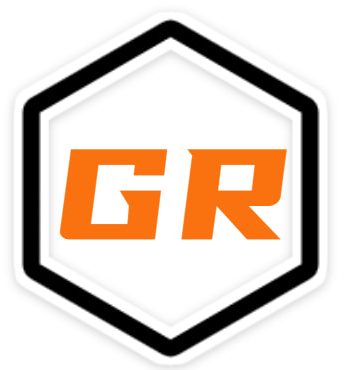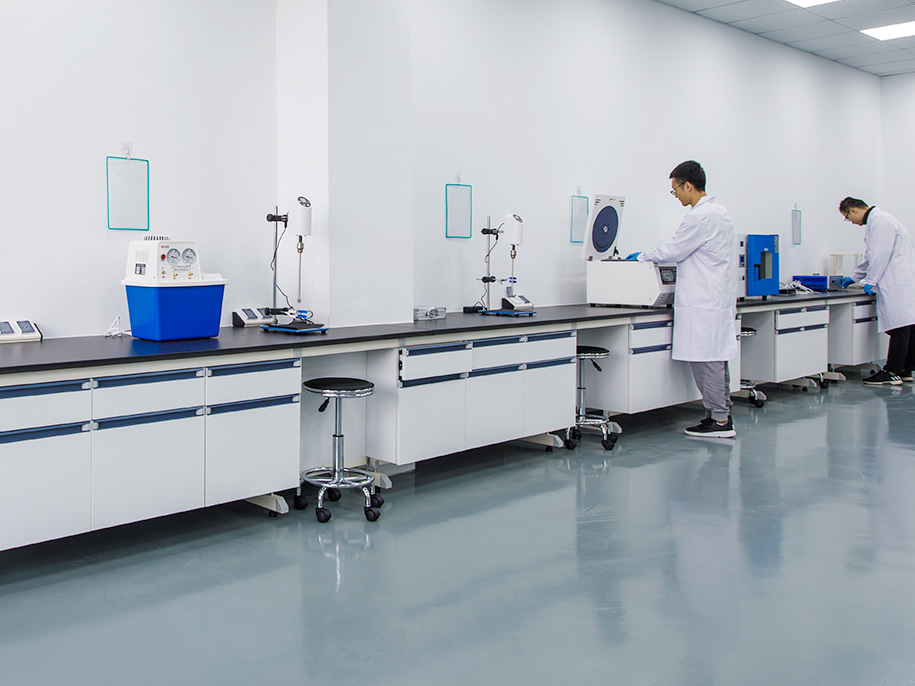Low-Cost, On-Demand Testing with Laser-Induced Graphene Digital Microfluidics Platform
Introduction
Digital microfluidics (DMF) is an emerging liquid handling technology with vast potential in various biological and biomedical applications. However, the traditional manufacturing of DMF chips is often complex, time-consuming, and expensive, severely limiting their widespread application, particularly in point-of-care testing (POCT). Although paper- or film-based DMF devices offer a cheap and convenient alternative, they are still affected by planar addressing structures, thus limiting the number of electrodes.
To address these issues, a research team from Zhejiang University recently published a paper titled “Laser-induced graphene-based digital microfluidics (gDMF): a versatile platform with sub-one-dollar cost” in the journal Lab on a Chip. This study introduces the development of a digital microfluidic chip (gDMF) based on laser-induced graphene (LIG). The proposed gDMF can be easily manufactured using a computer-controlled laser scribing process (within 10 minutes, under ambient conditions, without expensive materials or cleanroom technology). Furthermore, both planar addressing DMF (pgDMF) and vertical addressing DMF (vgDMF) are easily achievable, with the latter potentially providing higher electrode density.
Figures and Data
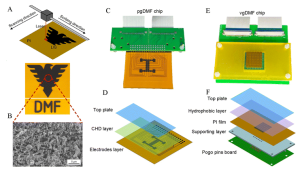
- Figure 1:
- (A) Schematic of laser-induced graphene (LIG) fabrication.
- (B) Scanning electron microscope image of LIG.
- (C) Photo and cross-sectional view of gDMF (pgDMF) planar addressing.
- (E) Photo and (F) cross-sectional view of gDMF (vgDMF) vertical addressing.
The manufacturing cost of the proposed gDMF is impressively low, with an overall cost of less than one dollar (pgDMF at $0.85 and vgDMF at $0.59). Experiments also show that the performance of pgDMF and vgDMF is comparable to traditional DMF devices, with colorimetric assays conducted on vgDMF demonstrating their applicability. Given the simplicity, low cost, and full functionality of gDMF, and the ability to modify electrode patterns for different applications, it is expected that the proposed gDMF could serve as a versatile platform for POCT.
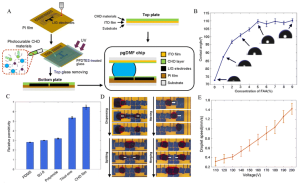
- Figure 2:
- (A) Schematic of pgDMF chip fabrication.
- (B) Contact angle of thiol-ene films doped with different FAA concentrations.
- (C) Comparison of relative dielectric constants between conventional dielectric films and CHD films.
- (D) Video images of droplet operations on pgDMF chips.
- (E) Droplet movement speed on pgDMF at different driving voltages (100 Hz).
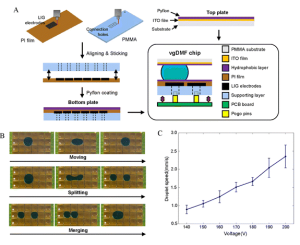
- Figure 3:
- (A) Schematic of vgDMF chip fabrication.
- (B) Video images of droplet operations on vgDMF chips.
- (C) Droplet movement speed on vgDMF at different driving voltages (100 Hz).
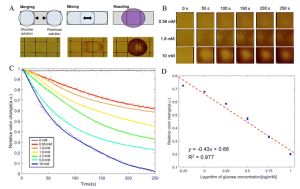
- Figure 4: Applications of gDMF devices.
Conclusion
This study reports on a DMF device (gDMF) based on laser-induced graphene (LIG), with notable advantages such as simple processing methods (computer-controlled laser scribing), easily achievable conditions (ambient, without expensive materials or cleanroom technology), and short manufacturing time (within 10 minutes). Additionally, both planar and vertical addressing DMF (pgDMF and vgDMF) can be easily realized, and electrode patterns can be easily changed as needed, offering high flexibility in various applications. The proposed gDMF also boasts an impressive cost of less than one dollar (pgDMF at $0.85 and vgDMF at $0.59), and the droplet operation performance is comparable to traditional chips, meeting the functionality and economic requirements of DMF technology.
Therefore, we believe that gDMF may find extensive applications in the biological and biomedical fields, particularly as low-cost disposable items in the POCT field. However, before practical application, some challenges remain to be addressed, such as more efficient laser scribing, mass production, and multiple material choices for LIG patterns to suit various situations. Additionally, various POCT applications (such as nucleic acid detection, protein detection, and cell analysis) still need to be developed on gDMF.
Paper Link: Laser-induced graphene-based digital microfluidics (gDMF): a versatile platform with sub-one-dollar cost
Source: Graphene Alliance
